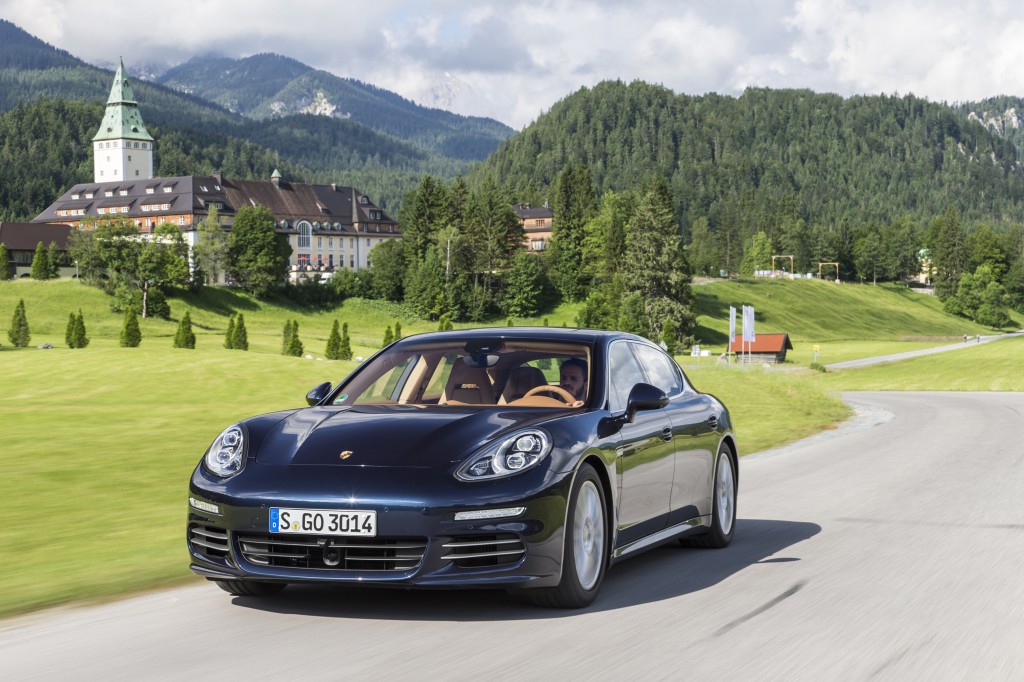First Drive: 2014 Porsche Panamera S
Story by John LeBlanc
MUNICH, GERMANY – In the face of outcries of blasphemy from purists, the Panamera — Porsche’s first-ever four-door, four-passenger luxury sedan/hatchback — quickly became a global sales success after its debut for 2010. In Canada last year, the Panamera sat third behind the new 911 Carrera 2+2 and the best-selling Cayenne SUV in overall sales.
In some markets, though, like the United States and China, the Porsche luxury sedan has become Porsche’s top-selling model, mainly as an alternative to traditional luxobarge sedans like the Audi A8, BMW 7 Series and Mercedes-Benz S Class. So when it came time for the Panamera’s traditional mid-cycle facelift, Porsche took a “don’t mess with success” approach.
For the new 2014 models arriving in Canada this fall, there are the usual detail styling changes, such as new front and rear fascia updates, tweaks to the interior and various new convenience and driver assistance systems. There’s also a new, long-wheelbase Executive model for Panamera owners who prefer to be chauffeured. But the biggest changes can be found under the 2014 Panamera’s long, front engine hood, where the issue of ever-tightening fuel economy regulations continues to be addressed.

The most fuel-efficient and technically interesting new model is the $113,300 (all base prices) 2014 Panamera S E-Hybrid I previously previewed, a vehicle Porsche claims is “the world’s first luxury plug-in hybrid.” Compared to the outgoing Panamera Hybrid’s 7.1 L/100 km estimate on the European cycle, the new plug-in version scores a remarkable 3.1 and up to 36 kilometres of driving under electric power only.
On the gas-only engine front, the 2014 Panamera will continue to offer four choices. The base model uses a carryover 3.6-litre six-cylinder, making 310 horsepower, in both the rear-wheel-drive version ($89,500) and all-wheel-drive Panamera 4 ($94,800). The RWD $129,400 Panamera GTS’s 4.8L eight-cylinder with 440 hp also continues, as does the $161,800 AWD Panamera Turbo, which uses a blown version of the V8, making 520 hp and now also available with the stretched Executive body for $184,100. Thinking ahead, Porsche says the facelifted Porsche Panamera Turbo S and Panamera Turbo S Executive will arrive in 2014.
I’ll have a full test drive of new 2014 Panamera S E-Hybrid in the future, but within the gas models, the big news is the $106,600 RWD Panamera S, $112,500 AWD Panamera 4S and $143,600 Panamera 4S Executive models. Replacing last year’s naturally aspirated 4.8L eight-cylinder is a twin-turbocharged 3.0L six, a heavily reworked version of the 3.6L unit in the base models. But don’t panic, Porsche’s made the transition from eight to six cylinders as painless as possible.

For starters, the Panamera S’s new twin-turbo V6 sports 420 hp (20 more than the older V8) and 384 pound-feet of torque (on par with the new GTS). On top of the two turbos, Porsche has also added a new fuel-injection system and variable valve timing on both the intake and exhaust side. To save fuel, a new extended start/stop function deactivates the engine earlier when coasting to a stop. Except for the Panamera S E-Hybrid (which gets an eight-speed automatic transmission) all 2014 Panamera models use a seven-speed Porsche Doppelkupplung (PDK) dual-clutch autobox. Except for the PDK in the Panamera GTS, the autobox now features a coasting function where the clutches open when overrun occurs, which Porsche says helps improve highway fuel economy.
All this engineering effort has made the 2014 Panamera S quicker and more fuel efficient. Its zero to 100 km/h time has dropped from 5.4 to 5.1 seconds. Porsche is also estimating an 18% drop in fuel consumption compared to the outgoing Panamera S’s 12.9 L/100 km city and 8.3 highway estimates.
After spending an afternoon on both two- and four-lane Bavarian roads, it’s hard to imagine any 2014 Panamera S owners crying, “I could have had a V8!” I was never a fan of the truck-like nature of the Panamera’s old V8, so the ease in which the new blown-V6 moves the rather large car from rest in such a refined and robust way only cements the argument that Porsche has made the right decision in downsizing the Panamera S’s engine bay. Porsche’s engine department added a balance shaft above the turbo-six’s crank for smoothness. As well, the V6 is lighter than the V8, its lower 90-degree cylinder bank angle drops the Panamera’s centre of gravity and allows the mill to be mounted further back toward the centre of the car to improve the vehicle’s handling balance and high-speed stability.

For Panamera owners who may prefer to be driven, I also spent some time in the back seat of the new Panamera 4S Executive. The 15 centimetre longer wheelbase frees up even more rear legroom for limo-like comfort. All Executive models also receive Porsche’s air suspension, which along with the longer wheelbase, delivers excellent ride comfort.
As a driving tool for the enthusiast, the Porsche Panamera continues to be a unique alternative to the typical big German luxury sedan, and the updates and refinements for 2014 make it only more so.







![[del.icio.us]](https://www.straight-six.com/wp-content/plugins/bookmarkify/delicious.png)
![[Digg]](https://www.straight-six.com/wp-content/plugins/bookmarkify/digg.png)
![[Facebook]](https://www.straight-six.com/wp-content/plugins/bookmarkify/facebook.png)
![[Google]](https://www.straight-six.com/wp-content/plugins/bookmarkify/google.png)
![[Reddit]](https://www.straight-six.com/wp-content/plugins/bookmarkify/reddit.png)
![[StumbleUpon]](https://www.straight-six.com/wp-content/plugins/bookmarkify/stumbleupon.png)
![[Twitter]](https://www.straight-six.com/wp-content/plugins/bookmarkify/twitter.png)
![[Email]](https://www.straight-six.com/wp-content/plugins/bookmarkify/email.png)